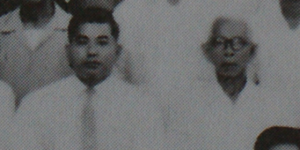As a continuation of the article on Kinjo UFUCHIKU Masanra, this is about one of his most notable students, Kina Shōsei (1882-1981). The informations here were collected and jointed from four different Japanese language sources.
Budōka and school teacher
Kina was born in 1882 in Higa, Nakagusuku-son, the present Shimabuku neighborhood in Okinawa City.
At the age of eighteen Kina received his initiation into the sai by older colleagues and friends from his community. In Shimabuku the exercise with sai was exceptionally highly valued and das saijutsu as a kind of self-defense (goshin-jutsu) was part of the customs and traditions of the young men from the area. It is said, however, that this was not a classified style of saijutsu, but a mimic of policemen who used the sai. Sai were carried along by the policemen called Chikusaji, which were employed as the king’s guards or for the control of crowds. Sai also served for the apprehension of criminals and are therefore comparable to the Japanese jūtte.
1906, during his time as a student at the teacher training college (Shihan gakkō) in Shuri, he heard of Kinjō Ufuchiku’s fame as a warrior who served at Shuri castle. Ufuchiku was an official rank comparable to a police commissioner. Therefore, this saijutsu was was an orthodox school. Soon afterwards he went and visited the Ufuchiku in Shuri and asked him to be allowed to become his pupil, which was outright rejected. But Kina, 24 years old at the time, had no intention of giving up his plan. He repeated his request on several occasions and was finally accepted as a student.
Kina devoted himself to intense exercise for more than five years, wherein he was initiated into thirty-five types of kobujutsu–kata, i.e. karate, saijutsu, bōjutsu u.a. According to Kina, saijutsu is a martial art that is used for self-defense and consists of the following main techniques: utsu, ukeru, tsuku, utsu–otosu, nuku, and haneru.
The Ufuchiku-den Kobujutsu mainly deals with various weapons and therefore may appear aggressive. The heart (kokoro) of kobujutsu however, which the revered teacher Kinjō Ufuchiku formulated in his creed, is as follows:
“Kobujutsu is a defensive, non-aggressive measure that strictly limits itself to national defense (senshu bōei); it has nothing to do with pre-emptive attacks (sensei kōgeki).”
According to Kina, one of Kinjō Ufuchiku’s rules was:
“The ultimate secret of warrior-dom (bu) is the heart (kokoro).”
Kinjō Ufuchiku is considered a pioneer of the traditional kobujutsu of Okinawa precisely because he cleary stated this morality of the martial virtues in a rigorous and strict manner. This provision holds true even today and is preserved in the moral teaching of karate ni sente nashi.
Kina passed away at the age of 99 years.
During his lifetime, Kina demonstrated the secrets of saijutsu at the theatre of Naha, was known as a practicing Christian and was active as a school teacher for thirty-two years. Corresponding to his peaceful disposition, he based his teachings on the idea of sai ni sente nashi. – there is no first attack in saijutsu.

Kyan Shin’ei (l.) and Kina Shosei, 1961 at the founding of the Okinawa Okinawa Kobudo Kyokai.
Among Kina’s students were Kyan Shin’ei, Izumikawa Kantoku, Kina Shōshin, Higa Seishin and others, all of which became well-known masters of saijutsu themselves. Kina’s particular strength is said to have been Chatan Yara no Sai and Tsuken Shitahaku no Sai.
© 2015, Andreas Quast. All rights reserved.
